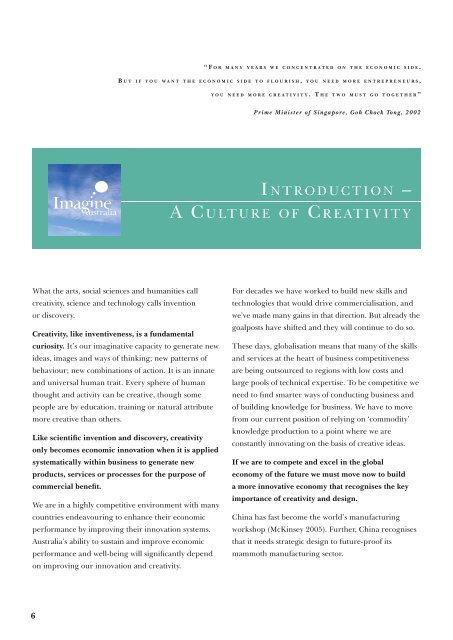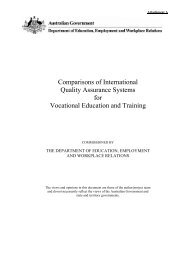IA02 PMSEIC Report.indd - Department of Innovation, Industry ...
IA02 PMSEIC Report.indd - Department of Innovation, Industry ...
IA02 PMSEIC Report.indd - Department of Innovation, Industry ...
Create successful ePaper yourself
Turn your PDF publications into a flip-book with our unique Google optimized e-Paper software.
“FOR MANY YEARS WE CONCENTRATED ON THE ECONOMIC SIDE.<br />
B UT IF YOU WANT THE ECONOMIC SIDE TO FLOURISH, YOU NEED MORE ENTREPRENEURS,<br />
YOU NEED MORE CREATIVITY. THE TWO MUST GO TOGETHER”<br />
Prime Minister <strong>of</strong> Singapore, Goh Chock Tong, 2002<br />
I NTRODUCTION –<br />
A CULTURE OF CREATIVITY<br />
What the arts, social sciences and humanities call<br />
creativity, science and technology calls invention<br />
or discovery.<br />
Creativity, like inventiveness, is a fundamental<br />
curiosity. It’s our imaginative capacity to generate new<br />
ideas, images and ways <strong>of</strong> thinking; new patterns <strong>of</strong><br />
behaviour; new combinations <strong>of</strong> action. It is an innate<br />
and universal human trait. Every sphere <strong>of</strong> human<br />
thought and activity can be creative, though some<br />
people are by education, training or natural attribute<br />
more creative than others.<br />
Like scientific invention and discovery, creativity<br />
only becomes economic innovation when it is applied<br />
systematically within business to generate new<br />
products, services or processes for the purpose <strong>of</strong><br />
commercial benefit.<br />
We are in a highly competitive environment with many<br />
countries endeavouring to enhance their economic<br />
performance by improving their innovation systems.<br />
Australia’s ability to sustain and improve economic<br />
performance and well-being will significantly depend<br />
on improving our innovation and creativity.<br />
For decades we have worked to build new skills and<br />
technologies that would drive commercialisation, and<br />
we’ve made many gains in that direction. But already the<br />
goalposts have shifted and they will continue to do so.<br />
These days, globalisation means that many <strong>of</strong> the skills<br />
and services at the heart <strong>of</strong> business competitiveness<br />
are being outsourced to regions with low costs and<br />
large pools <strong>of</strong> technical expertise. To be competitive we<br />
need to find smarter ways <strong>of</strong> conducting business and<br />
<strong>of</strong> building knowledge for business. We have to move<br />
from our current position <strong>of</strong> relying on ‘commodity’<br />
knowledge production to a point where we are<br />
constantly innovating on the basis <strong>of</strong> creative ideas.<br />
If we are to compete and excel in the global<br />
economy <strong>of</strong> the future we must move now to build<br />
a more innovative economy that recognises the key<br />
importance <strong>of</strong> creativity and design.<br />
China has fast become the world’s manufacturing<br />
workshop (McKinsey 2005). Further, China recognises<br />
that it needs strategic design to future-pro<strong>of</strong> its<br />
mammoth manufacturing sector.<br />
6
















